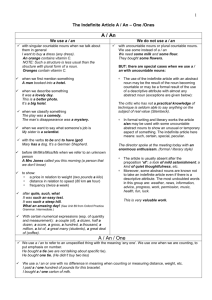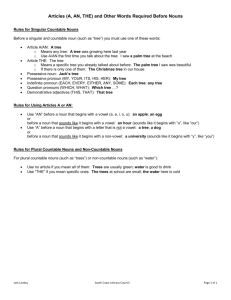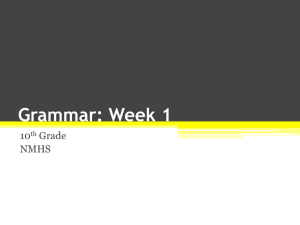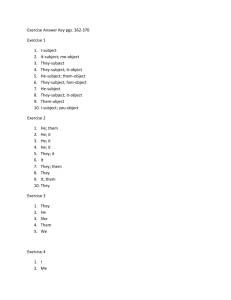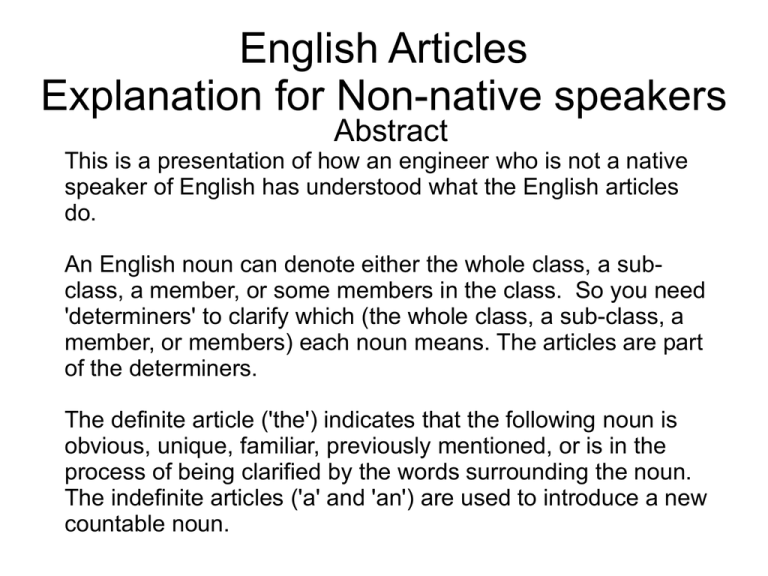
English Articles
Explanation for Non-native speakers
Abstract
This is a presentation of how an engineer who is not a native
speaker of English has understood what the English articles
do.
An English noun can denote either the whole class, a subclass, a member, or some members in the class. So you need
'determiners' to clarify which (the whole class, a sub-class, a
member, or members) each noun means. The articles are part
of the determiners.
The definite article ('the') indicates that the following noun is
obvious, unique, familiar, previously mentioned, or is in the
process of being clarified by the words surrounding the noun.
The indefinite articles ('a' and 'an') are used to introduce a new
countable noun.
Nouns are ambiguous
In this presentation, a class means the group of things having
similar nature so that one common name (noun) has been
assigned to refer to all the members. A class consists of individual
members, and those members having similar features that are
different from other members may form sub-classes.
For example, suppose you had a dog named Fido. He is a beagle.
Dog is the class name, beagle is a sub-class. Fido is a member of
the sub-class beagle, which is a member of the higher class 'dog.'
( see the next slide) Dog is also a sub-class of the larger class
'animal'
Using one noun to refer to the whole class or a member or some
members in the class is convenient. But on the the hand, it is
problematic because the noun by itself has no method to tell
which(class or a member) you are referring to. When you think
'dog', as long as you are just thinking by yourself, just 'dog' will do
because you know exactly what you are referring to.
Classes and members
Collie
Dachshund
DOG
Beagle
Shepherd
Fido
ANIMAL
Articles are needed to clarify
But when you communicate with others, who cannot see what's in
your brain, you need to add more information to the noun 'dog' to
make it mean exactly what you want to. From just hearing 'dog' a
listener cannot tell what you mean. Is it your Fido, or your
neighbor's dog, the dog you saw at the kennel, or the dog in the TV
commercial, or some beagles, or even all the dogs in the world?
So the communication fails due to the ambiguity.
In English, special group of words called 'determiners' are used
before nouns to take care of this problem of ambiguity.
Articles are part of this determiners. Articles add information and
help 'determine'' exact meaning (class/member scope) of the
nouns they are attached to.
Determiners
A determiner makes a noun following it specific by clarifying class
membership ambiguity. It selects one, some, all, or no members of
the class denoted by a noun. Determiners are;
My, your, our, their, his, her, it's (possessive)
Some, several, all, any, many, few, no, each, every,
either, neither ( selector )
This, that, these, those (pointer)
A, an, the, (articles)
The determiners are mutually exclusive. You can only use one
determiner word for a single noun. You cannot say 'the my dog'
nor 'my this dog.'
Of all the determiners, the articles have the lowest priority, so when
other determiners are used, the articles are omitted.
How to specify members -1
1. By using determiners ;
Some/my/your/any/no/each dog
2. By using specific name of a member
Fido, Pooch, Spot, Jiro
3. By referring to the previous mention
I saw a dog on the street. The dog barked at me.
4. By describing feature; size,color, sub-class name, etc.
The brown dog. The beagle. The small dog.
5. By mentioning the condition
I was looking at the sick/healthy/happy/sad dog.
6. By mentioning the position in rank, order, space, or time
The best dog. The first dog in the row.
The dog I saw yesterday. The dog in the cage.
How to specify members -2
7. By mentioning result of action, or by relation
The dog (that/which) I brought in. The dog chained to the post.
8. By mentioning action the noun object is performing
The dog chasing after the car.
9. By being unique, in proximity, familiar, or obvious
Open the door/window. Put your book on the desk/table.
Mother went to the bank/post-office/station/market.
The sun, the moon, the earth
The street, the mayor, the governor, the town
(Familiarity is culture dependent. Parts of your body are
assumed to be very familiar, so they always need 'the')
Methods 4 - 8 can be used in combination until the ambiguity has
been cleared : The barking short tailed brown beagle under the
table.
Methods 3 - 9 above use the definite article 'the' to indicate status
of the specifying task as either 'done' or 'in progress'
Definite and indefinite articles
The definite article 'the' is used to indicate that the noun following it
has been previously mentioned, or is so obvious as not to need any
explanations due to local or global familiarity, uniqueness, proximity
or visibility, or is now in process of being clarified by the words
surrounding it.
In contrast, the indefinite article 'a/an' is used to temporarily mention
one member of the class denoted by a noun without making specific
as to which exact member the noun is referring to. It is used to
mean 'any one member' of a class. Since it only can mean 'one', it
cannot be used to mean multiple members nor used for uncountable
nouns.
Other use of indefinite articles
Main usage of the indefinite articles 'a' or 'an' was to denote 'any
one member of a class.'
In addition to this usage, there are other uses of the indefinite
article. In the following examples, they are used to mean 'one' and
by extension, to mean 'the same', or to mean 'per one' as .
A thousand people saw it.
The room charge is $200 a night.
Birds of a feather flock together.
one thousand
$200 per one night
Birds having the same feather
Introducing a new noun
So, which article do you use when you want to bring a noun into
your conversation or writing?
If the noun has appeared before and is still remembered,
or if the noun refers to a visible thing located near you,
or if the noun refers to a familiar or unique thing,
or if there are words around the noun to specify it's location in rank,
order, time or space,
or if it describe specific features/conditions of the noun,
---> Use definite 'the'
(In these cases, you can replace 'the' with 'that' without changing
the meaning. Both you and the listener can understand what is
meant by 'that' thing. )
If the noun is plural or is uncountable ---> Use no article.
If the noun is countable and singular ---> Use 'a' or 'an'
Second time mention
After a singular countable noun is introduced by using 'a/an' before
it, the noun becomes clarified (specified, defined) for the listener or
reader. So, from that point on you can use the definite article 'the'
to refer to the same noun. In a way using 'the' here is equivalent to
saying 'thing that has been already introduced.'
This second mention rule applies to synonyms as well.
I saw a dog across the street. The animal/beagle/dog/canine was
barking at the mailman.
Combine butter, sugar, and eggs. Add flour to the mixture.
Here, 'mixture' is a synonym for the first three ingredients.
(This example is from Peter Master's article in April 1988 issue of the English Teaching
Forum)
Countable and Uncountable Nouns
The definite article 'the' can be used for all nouns regardless of
countability, but the indefinite articles 'a' or 'an' are used only for
singular case of countable nouns.
Countable nouns are those denoting objects that are visible and
tangible and having fixed shapes.
Uncountable nouns do not have fixed shapes, and some are
invisible. Even though tangible and visible, things having no fixed
shape such as liquid, gas, powder, grain, are not considered
countable. Such nouns are called mass nouns.
Nouns denoting intangible and invisible things, like emotions,
concepts, ideas, are called abstract nouns and are uncountable.
Noun countability
PROPER
ABSTRACT
MASS
INVISIBLE
VISIBLE / TANGIBLE
UNCOUNTABLE
Countable using
Adjectives
CONCRETE
Countable using
measure words
COUNTABLE
COUNTABLE
Countable is cultural
What is countable in English may not be considered countable in
your native language.
When in doubt, consult with a proper English dictionary that has
countable/uncountable classification.
The following is a list of words Japanese learners of English often
mistake as being countable.
Advice, assistance, data, energy, equipment, furniture, information,
knowledge, luggage, power
Countability is context dependent
Some nouns (especially abstract nouns) have multiple meanings
and can be countable or not countable depending upon context.
Examples;
It is time to go. (uncount) I came here three times. (count)
Based on fact (uncount) Get the facts straight (count)
Apply pressure (uncount) Plot pressures on a graph (count)
He is under fire (uncount) Build a fire for the camp (count)
He is in hospital (uncount) I see three hospitals in the map.
The meeting is in session Some sessions were interesting.
Counting the Uncountables
There are some ways to count uncountable nouns.
One method is to use adjectives or relative phrases to attribute
specific feature or property to a noun. Once a special feature is
attributed, the noun becomes a unique instance of the uncountable
noun. Being unique allows it to be counted.
A blue sky, a beautiful scenery, a happiness that lasted weeks
Another method available for counting mass nouns is by using a
unit of measurement or a container to fix the amount (mass)
A cup of coffee, a piece of cake, a slice of meat, two kilos of resin
Still another method, common in science and engineering is to
focus on 'values' abstract nouns can have and use a plural form.
Pressures measured were plotted. (there are many value of the
pressure, or many measurement points)
Articles selection process
Write out your sentences. Write the whole paragraph or if short the
whole document. This will be useful when checking for the
previous mention of a noun.
For each noun, do;
If a non-article determiner is found, no need to use the articles.
If the noun meets one of the following, use 'the'
is familiar, well known, unique, visible and near
has been previously mentioned and is still current
has phrases starting with 'which' or 'that' to give attributes
has phrases specifying location in rank, order, space, or time
has phrases specifying action or result of action
Else
If plural or not countable, do not use 'a' or 'an'
If first time single countable, use 'a' or 'an'
End if
After all done, check idiomatic patterns for special handling.
Summary
A noun can denote either the whole class, a sub-class, a member,
or members in the class.
Determiners are needed to clarify which (the whole class, a subclass, a member, or members) a noun means.
The articles belong to the determiners.
The definite article flags that the noun following it is obvious,
unique, familiar, previously mentioned, or is in the process of being
clarified by the words surrounding the noun.
The indefinite articles are used to introduce a new countable noun.
Once a noun is introduced, you can use 'the' from the second time
on.
Nouns are either countable or uncountable.
Things denoted by countable nouns have fixed shapes and are
visible and tangible. Things denoted by uncountable nouns do not
have fixed shapes.
A specific instance of uncountable nouns can be counted.
Acknowledgment and disclaimer
I am obligated to the internet and all those nice people who made many useful
English grammar tutorials and research papers available on the net. Without freely
available information on the internet, I would have been confined to using outdated
hard copy books and my progress would have been terribly slow.
The understanding that the nouns have ambiguity because they refer to both a
class and members in the class, and that determiners including the articles are
used to clarify that ambiguity is my own so the blame is entirely on me if this idea is
wrong. It just seemed a natural way to make an engineer understand the concept.
I am an engineer by trade. I encountered difficulty learning the articles, so started
to investigate ways to improve the situation. I came to this realization of the role of
the articles as being 'class ambiguity clarifying flags' after noticing some similarity of
the articles with how variables are handled in computer programming languages.
This presentation is released in hope that non-native English learners, especially
those engineers having hard time learning English, may benefit from this different,
engineer oriented explanation of how the articles work.
All rights reserved by Takeharu Gima. Feb 14, 2014. You are free to use and
distribute this presentation and the information contained as long as it is for your
personal use and not for commercial purpose. Contact: Takeharu.gima@gmail.com


